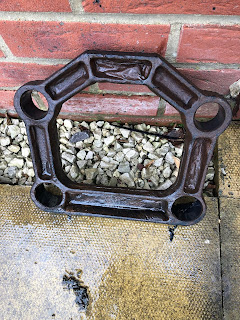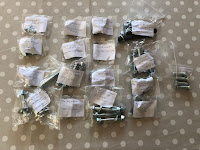I am very behind where I had hoped to be in terms of donor part preparation.
The chassis and body kit have been delivered but, although I have stripped down both the front and rear axles (except for my saga with the rear hub taper bearing), I have not degreased, de-rusted or re-painted any of the parts.
My previous experience with working on cars has told me that there is no miracle when it comes to removal of rust. It comes down to elbow grease and plenty of wire brushing (unless one has one's own sand blasting cabinet - which unfortunately I don't!).
I am also not a fan of the various rust encapsulation products that are available (POR-15 and the like). While many people swear by them, again my experience has taught me that the only way to prevent rust from coming back is to remove it completely before attempting any painting or coating.
That said, while I was looking through the various auto restoration catalogues that I have, plus some internet / forum browsing, there do seem to be products available that do 'what they say on the tin' and remove rust. One that caught my attention was Bilt Hamber deox-C. This is mentioned on many of the automotive forums, generally in positive terms, plus it was also used with great success and recommended by my fellow local builder, Richard.
 |
| Photo courtesy of Bilthamber.com |
"deox-C is a crystalline, 100% active corrosion removal product formulated for the removal of corrosion products from steel, stainless steel and most ferrous materials. This product when dissolved in tap water, produces a bath of powerful rust removing liquid."
All sounds very good. The only downside I could see was the price, as 4kg of deox-C runs at a shade under £50 and I figured I was going to need a fair amount to immerse all my bits. So embracing my wife's new fiscal strategy, I continued to look for cheaper solutions (no pun intended!).
Further internet browsing revealed that the primary active ingredient in deox-C is citric acid. The science bit goes along the lines of:
Citric Acid + Rust = Iron Oxide + Carbon Monoxide + Water + Hydrogen
Or for those of us who did chemistry at school many years ago....
C6H8O7 + Fe2O3 = 2 FeO + 6 CO + 2 H2O + 2 H2
However the really important bit for me was that I could pick up 5kg of Citric Acid plus a small aquarium heater (rust removal process works best if solution is maintained at around 20degC) from amazon for £20!
 |
| Rust busting on the cheap..!! |
So armed with a large plastic bucket, I made up an approximately 10% solution of citric acid by dissolving 2kg of the crystals to around 18 litres of hot tap water. I added the aquarium heater (I used a 50W heater) set to around 24degC and my rust removal bath was ready!
 |
| Ready for a bath... |
The first bits to be de-rusted were the rear pendulum bracket, the rear wishbone tie and the rear spacer tubes - these were all quite heavily corroded. I just immersed them in the bath without any prior treatment - no washing or brushing - just straight in! Surprising bubbles started forming on the surface of the metal very quickly and before long the solution was gently bubbling away! I covered the top of the bucket with a foil lid and left it for a week for the magic to happen.
 |
| Its a kinda magic...! |
A week later when I took the foil off the top of the bucket I was greeted with a delightful black swampy looking bucket.
 |
| One week later! |
Then I set to work with a bucket of hot soapy water and various nylon, brass and steel brushes. To say I was impressed would be an understatement. All surface corrosion had been converted to a grey sludge which washed off quite easily giving clean metal underneath. The solution also managed to loosen off most of the remaining paint on the parts which again brushed off with little effort.
 |
| Rear Pendulum - before... |
 |
| On removal from the acid bath... |
 |
| After a wash and brush up! |
 |
| Rear wishbone ties and spacer tubes before... |
 |
| Rear wishbone tie after wash and brush |
I forgot to take any pictures of the spacer tubes after their initial clean but they had come up practically like new with just a couple of spots of corrosion left on them. The eagle-eyed of you will also notice that the wishbone tie in the photo above is my original one (with the missing and irreplaceable bushes). There is a reason for that - which I will come to in a future post.
After the initial clean of the parts there were still a few areas of corrosion left so I decided to give them a dunk for another week (plus I stuck in the front brake calliper carriers at this time for a soak as well).
WORD OF WARNING - it is possible to leave parts in the acid solution for too long. Once there is no more rust for the solution to work on, it starts to etch the surface of the metal (causing microscopic pitting of the surface). I read this on the internet after I had worked it out for myself. After two weeks of immersion of the heavy cast pendulum bracket was unaffected, but the thinner metal brackets on the wishbone ties were showing some minor pitting and the spacer tubes, which after one week looked almost new, were extensively pitted. Nothing that a good wire brushing / flap wheel won't cure - but something to be aware of!
 |
| Etching of surface due to over immersion |
A final wash and brush of all the other parts, plus a quick tidy up with a wire brush in my drill has left the first batch of parts looking nice and shiny and ready for re-painting / coating.
 |
| After bathing for two weeks and a quick wash.. |
 |
| ...followed by a quick wire brushing = shiny parts! |
I have to say the results were far better than I was expecting and will be working my way through the rest of my rusty donor parts in the same manner.




































